Fiasco Italo-Brittanico
Part 15: 90CA on active duty - about the Alfa Romeo V8 engine
Author
- Henri Greuter
Date
- May 19, 2009
Related articles
- March-Alfa Romeo 90CA - Fiasco Italo-Brittanico, by Henri Greuter
- Introduction
- Part 1: Alfa's inverse Midas touch
- Part 2: Indy teams keep on March-ing
- Part 3: The Indy project that became a blackmail project
- Part 4: Patrick Racing, a brief history up to 1989
- Part 5: 1989 - Alfa picking up the pieces
- Part 6: 1989 - Winning major prizes on the road to losing everything
- Part 7: 1989 - The first Alfa Romeo-powered CART racer
- Part 8: 1989 - A hopeful start for Alfa Romeo
- Part 9: Preparing for 1990
- Part 10: The 90CA in more detail
- Part 11: Exhaust solutions a 'waste' of effort?
- Part 12: 90CA on active duty - up to halfway into the month of May
- Part 13: 90CA on active duty - the early part of the second week of practice at Indianapolis
- Part 14: 90CA on active duty - wrestling through the second week of practice and qualifying
- Part 16: 90CA on active duty - the last part of 'Indianapolis'
- Part 17: 90CA on active duty - after Indianapolis
- Part 18: The end of the road for March in CART and as a whole
- Part 19: The left-over hardware and where to find it
- Part 20: Final verdict on the March-Alfa Romeo 90CA
- Appendix I: Specifications
- Appendix II: Results and scores
- Appendix III: March-Alfa Romeo 90CA-related collectables and memorabilia
- March-Porsche 90P - The last oddball at the Indianapolis Motor Speedway, by Henri Greuter
Who?Al Unser Sr What?March-Alfa Romeo 90CA Where?Indianapolis When?1990 Indianapolis 500 (May 17, 1990) |
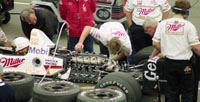 |
Why?
It had not been without difficulties but the Alfa Romeo V8 was to make its debut at Indianapolis in 1990. One unusual detail of the engine was that it had oil pumps high up, compared to low alongside the crankcase. Instead they were located at the front, under the cylinder blocks. The arrangement was beneficial to making the ground effects tunnels as wide as possible. But with the pumps higher up, the center point of gravity was raised.
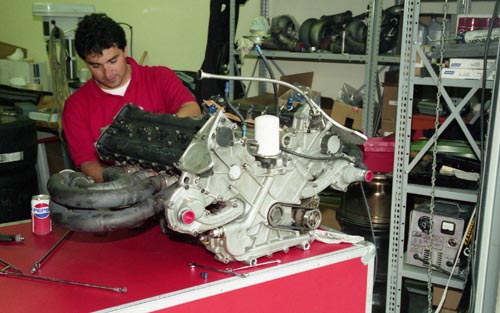
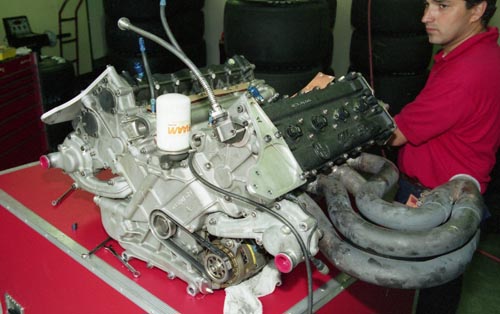
The unusual location of the oil pumps on the Alfa Romeo V8. (photo HG)
Installed in the car, the engine appeared to be rather compact, or was it a matter of a somewhat bulky chassis?
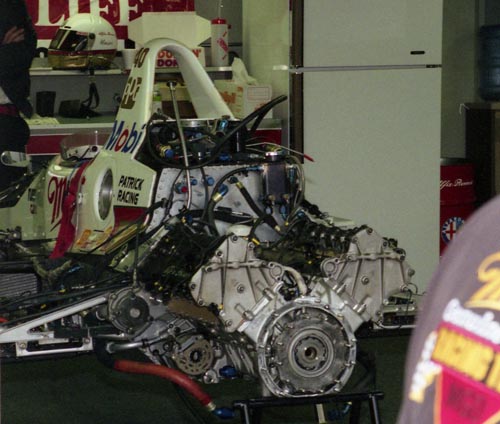
The V8 block with some of the auxiliary equipment around it not in place. (photo HG)
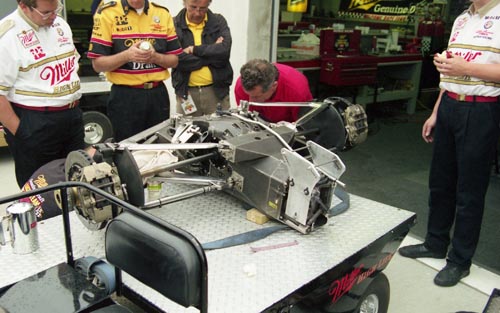
The gearbox unit with rear suspension attached. (photo HG)

Quite a piece of craftsmanship: the inlet plenum installation. (photo HG)
In the introduction part of the car it has been pointed out already that the 90CA had a turbo arrangement, and in particularly a wastegate flow arrangement that I think was questionable. Regrettably I didn’t get a lot of opportunities to see the March 90CA without its engine cover installed and if I did, I rarely got a good sight of it.

The March 90CA without its engine cover. Though the turbo is hidden deep within the car, the wastegate exhaust pipe is clearly visible. (photo HG)
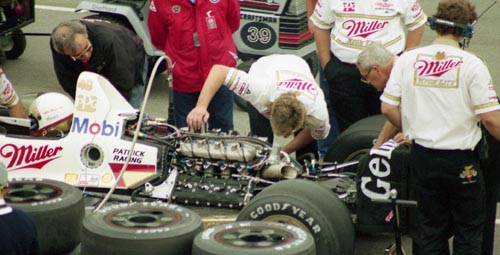
Seen from a distance it didn’t look that bad. (photo HG)
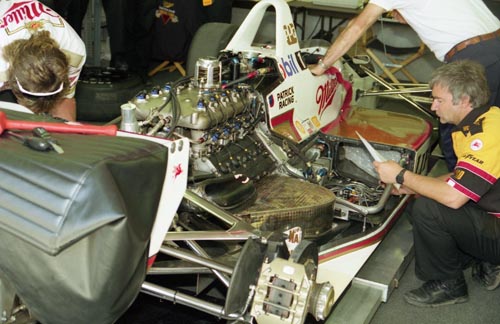
The engine installation seen at the right side, The black trunk-like device above the exhaust, in front of the suspension upright is the inlet to the turbo. (photo HG)
If the turbo and exhaust arrangement was responsible for the one outstanding feature of the Alfa Romeo is unclear. But the Alfa V8 was easily recognizable when it was driven at speed. No other engine had such a high-pitch scream as the Alfa V8.
On the third day of qualifying I had the privilege to be a guest of the Indianapolis Motor Speedway Corporation, being invited to attend the day from their suite that was part of the newly finished Tower Suites along the front straight. Among the items I brought with me that day was a pocket tape recorder for making interviews in case I should meet interesting people. I also used the recorder to make sound registrations of what I felt were the most interesting cars, the Alfas among them.
Though it is not of HiFi stereo quality, here are the sound recordings I made of the Alfas. Regrettably, the high-pitch scream of the Alfa V8 didn’t come off so good on tape as it sounded in reality.
The aborted first qualifying attempt of Roberto Guerrero because of a sick engine (WMA format, 2.0 GB)
Al Unser Sr’s qualifying attempt (WMA format, 3.9 GB)
I then went to the pit lane to have a look out there. It so happened that when I was down there, Roberto Guerrero made his second qualifying attempt of the day. I recorded it as well on that location, thus being much closer to the track than I was during the attempt by his team mate.
Roberto Guerrero’s second qualifying attempt (WMA format, 3.2 GB)
As to the question how much the Alfa Romeo V8 was still effectively the Ferrari 034 CART engine… It is rather remarkable but both Italian V8s had a bore and stroke of 86x57mm. Thus nothing changed in what was believed to be the ideal bore vs stroke ratio. But the Ferrari 034 had a slightly higher compression rate (11.5) compared to the Alfa (11.0).
To close off this chapter about the Alfa Romeo engine, here are a few engine specifications that were available about some of the opposing engines in 1987. (Source: International Racing Engine Directory, Ian Bamsey, Haynes Publishing Group, 1988.) Also added are the comparative figures found in the 1990 Porsche press kit on the 1990 Indy Porsche V8.
| Ferrari 034 | Alfa Romeo Indy V8 |
Chevrolet Ilmor 265A | Cosworth DFX | Porsche Indy V8 | |
| Year | 1987 | 1990 | 1987 | 1987 | 1990 |
| Bore x Stroke (mm) | 86 x 57 | 86 x 57 | 88 x 54.4 | 89 x 53.1 | 88.2 x 54.2 |
| Valve angle | 24 degrees | 32 degrees | |||
| Compression ratio | 11.5 | 11.0 | 11.0 | 11.0 | 12.0 |
| Max rpm | 12,000 | 11,900 | 12,500 | ||
| Weight | 155kg | 140kg | 150kg |
And then, a thought…
About the weight figures given in the stat above, I couldn’t figure out if this with which auxiliary equipment fitted. So it is difficult to give much credit to these values and base conclusions on it.
But if all engines were in similar trim, fitted with the same auxiliary equipment, then one can wonder. The Alfa Romeo V8 was praised for being such a compact engine. Crankcase and cylinder heads were out of aluminium. But then, how could the Alfa still end up being the heaviest engine among the ones with their weight listed? And compared to the engine to have (Chevy) that much heavier too?
